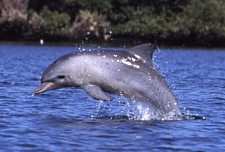Wildlife - Species
Bottlenosed Dolphin (Tursiops truncatus)
Description
The bottlenosed dolphin is one of 79 species of cetaceans. Its common name originates from its blunt snout, or rostrum. These aquatic mammals are silver-grey on top with pale grey, white or pinkish bellies. They may grow to 3.6 meters (12 ft) in length, but they commonly measure 2.4-2.7 m (8-9 ft) with an average weight of 180-270 kg (400-600 lbs). The lateral fins of a dolphin are called flippers, and its tail is called a fluke. Over time, their dorsal fins acquire notches and scratches that are used by scientists to identify individual dolphins. As all mammals, bottlenosed dolphins have hair (a few whiskers on their faces) and nurse their young.
Preferred Habitat and Biology
The bottlenosed dolphin is a common inhabitant of temperate oceans and coastal waters around the world. Along the east coast of the United Sates, bottlenosed dolphins range from Maine to Florida. This species of dolphin occupies different habitats throughout its range. Some dolphins are residents of coastal waters, and others lead a pelagic existence, traveling long distances across the world’s oceans. In South Carolina, the bottlenosed dolphin is the most common mammal inhabiting estuarine habitats as well as open water.
Inshore dolphins live in bays, lagoons, and estuaries and travel short distances in groups of four or five. Offshore animals gather in groups that may number in the hundreds and migrate north and south during the year following prey. Oftentimes groups of dolphins associate with gatherings of other marine mammals such as whales. This association affords protection and makes it easier for both parties to find food. Dolphins use several different feeding techniques to catch fish, shrimp, crabs, and squid. Females reach sexual maturity at 7-10 years of age, breeding is seasonal with most activity in the spring, gestation lasts 12 months, and the young begin eating fish at 6-7 months of age.
Species Significance
Dolphins are not threatened or endangered but are protected under the Marine Mammal Protection Act. Dolphin are commonly residents in the estuarine areas of the ACE Basin and can be observed from shore and from boats.
References
Heyning, J.E. 1995. Masters of the ocean realm: Whales, dolphins and porpoises. University of Washington Press, Seattle, WA.
Kelly, W.J. 1993. Dolphins that feed on land. Undercurrents 2(3):2-5.
Simbeck, R. 1997. For wildlife watchers: Bottlenose dolphin. South Carolina Wildlife 44(3):42-43.

